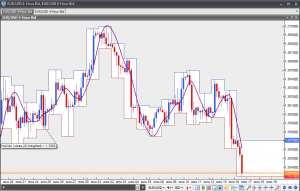Hull Moving Average
This lesson will cover the following
- Explanation and calculation
- How to interpret this indicator
- Trading signals, generated by the indicator
Developed by Alan Hull, it is an indicator, that solves the problem with making a moving average more reactive to current price activity. The Hull Moving Average almost eliminates lag and manages to improve smoothing.
The HMA manages to stick to rapid changes in price activity, as it has superior smoothing over a Simple Moving Average of the same period. The HMA employs Weighted Moving Averages (WMA) and dampens the smoothing effect. It can be calculated as follows:
HMA(n) = WMA(2*WMA(n/2) – WMA(n)), sqrt(n))
First, we need to take the WMA of the last ”n/2” data and multiply it by 2. Then, we need to subtract the WMA of the last ”n” data. Next, we need to take that value and use the square root of n. After that we need to calculate the WMA of those two values (it is the WMA [sqrt of n] of the remembered value). As the square root truncates values, we should choose an n that is a perfect square, such as 4, 9, 16 etc.
This indicator can be used in all the ways traditional moving averages are used, with the exception of crossover signals, because the latter depends on lag.
